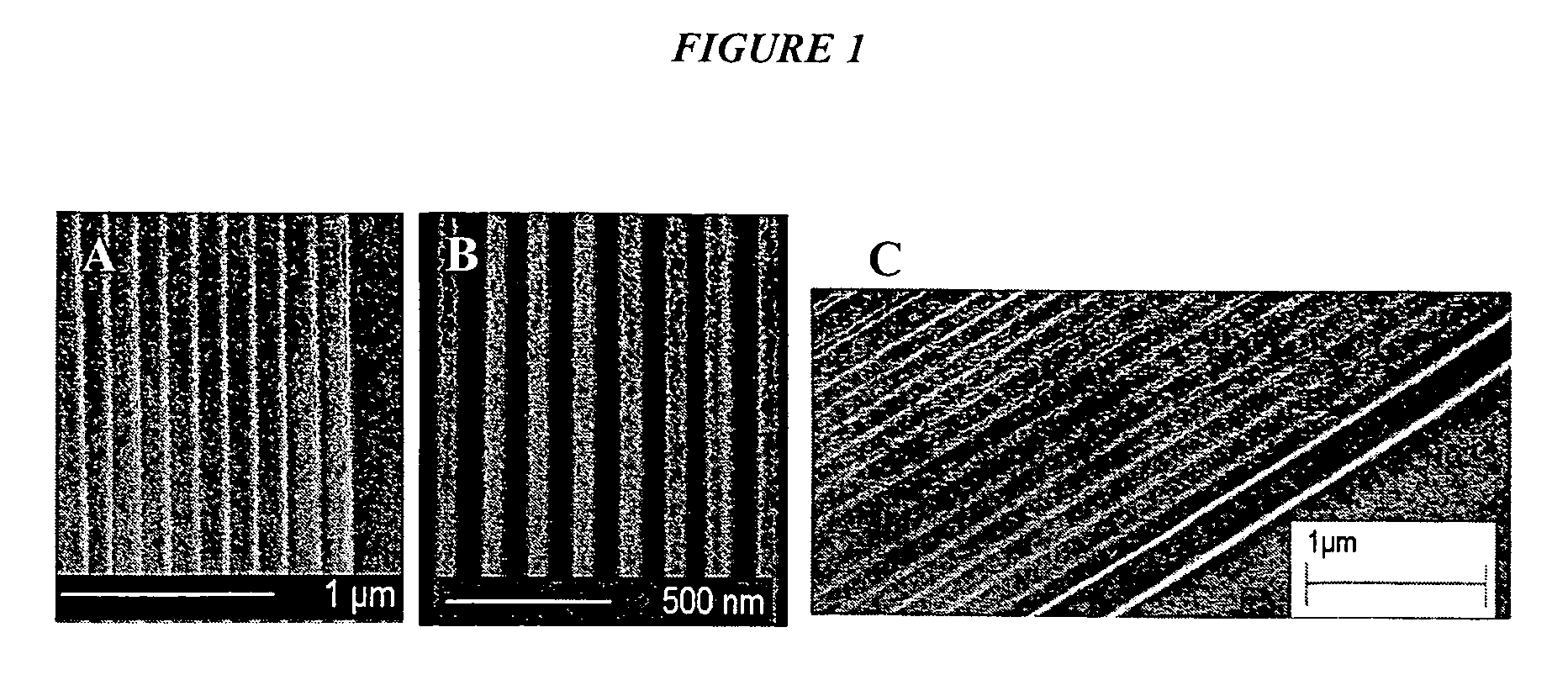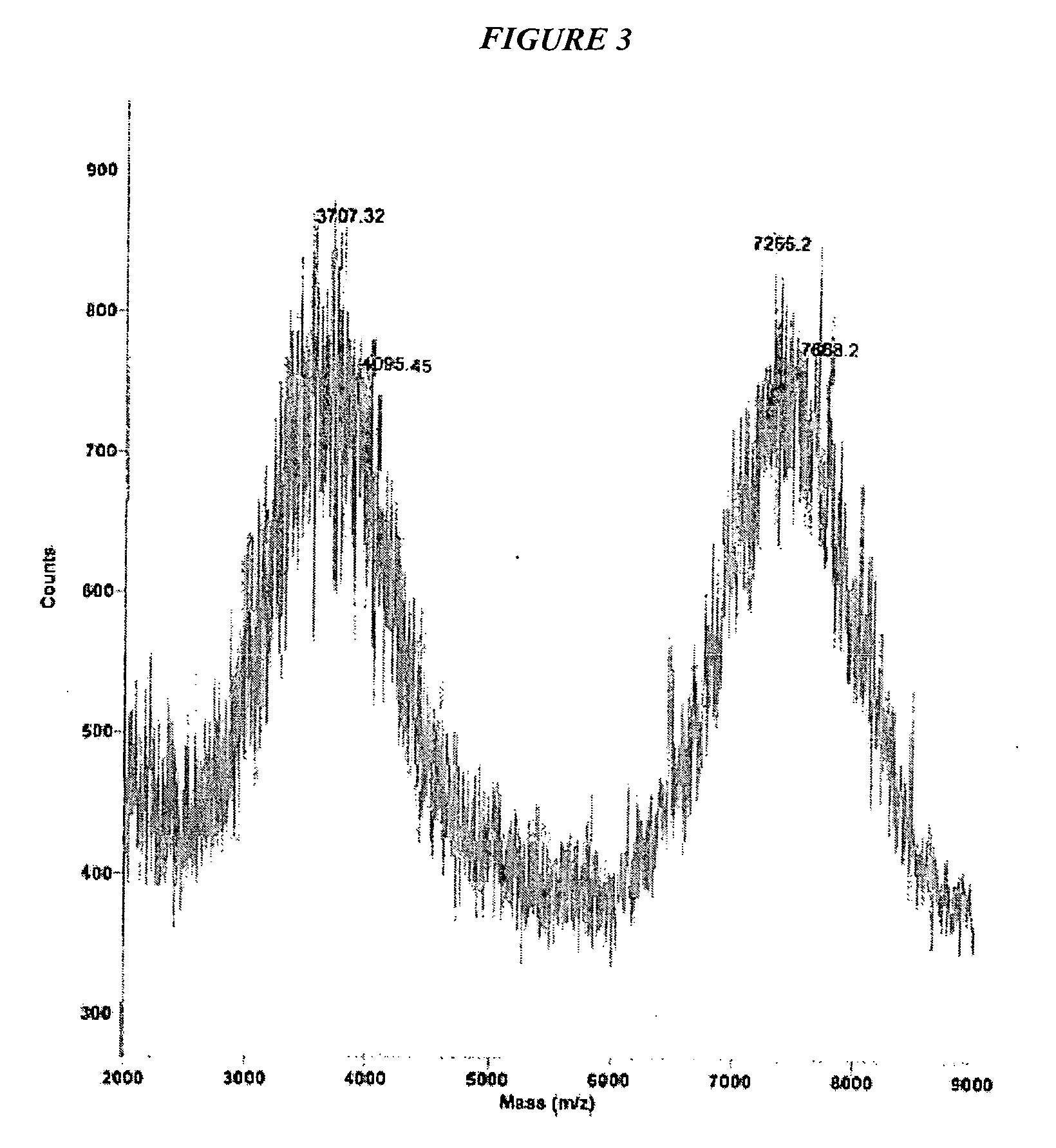Methods for fabricating nano and microparticles for drug delivery
a nano-particle and nano-particle technology, applied in the field of nano-particle fabrication methods for drug delivery, can solve the problems of lack of correlation between in vitro observations and in vivo performance of diffusion/degradation controlled devices, and inability to accurately predict drug diffusion/releas
- Summary
- Abstract
- Description
- Claims
- Application Information
AI Technical Summary
Benefits of technology
Problems solved by technology
Method used
Image
Examples
example 1
Incorporation of the Peptide GFLGK in a Photocrosslinkable PEG Polymer
[0063] The peptide sequence GFLGK (molecular weight (MW) 527 Daltons, synthesized at ICMB Protein Facility at the University of Texas at Austin) was reacted with acrylate-PEG-N-Hydroxy-succinamide (ACRL-PEG-NHS, MW 3,400, Nektar Therapeutics, AL). The primary (alpha) amine of Glycine (G) and the primary amine of Lysine (K) at either end of a peptide molecule reacts with the N-Hydroxy-succinamide (NHS) groups of two hetero-bifunctional PEG chains, i.e., each peptide molecule crosslinks two PEG molecules. This creates a 2:1 molar reaction (ACRL-PEG-NHS: GFLGK) to form ACRL-PEG-GFLGK-PEG-ACRL (a homobifunctional PEG diacrylate). Specifically, the peptide was dissolved to a final concentration of 1 mg / mL in 50 mM sodium bicarbonate buffer, pH 8.2. Separately, the ACRL-PEG-NHS was also dissolved in 50 mM sodium bicarbonate buffer, pH 8.2. The PEG solution (300 μL) was then added one drop at a time into the peptide sol...
example 2
Fabrication Using Nanoimprint Lithography Technique
[0069] We employed the S-FIL nanoprint process (discussed supra) to imprint nanopatterns on polymers. In addition to the S-FIL method, we employed a thermal nanoprint process to imprint nanopatterns on a variety of other polymers including PMMA, BCB, hydrogensilsesquioxane (HSQ) and the electron beam resist ZEP 520A (FIG. 1). In this thermal nanoimprint process, the polymer film was heated to a temperature slightly higher than the glass transition temperature. The imprint template was treated with a release layer (such as Hexadecanethiol or Octanethiol for a GaAs imprint template) to facilitate the separation of the template from the polymer layer upon cooling. Because the polymer does not need to be photo-linkable, the thermal nanoimprint process can be used to pattern a wide variety of polymers.
example 3
Fabrication of Templates for Thermal Nanoimprinting of Drug Delivery Lidded Particles
[0070]FIG. 4 shows a schematic for the nanoimprint fabrication process of lidded particles as shown in FIG. 5, infra. Two reusable quartz templates for nanoimprinting are fabricated as described.
[0071] To make an example particle for use as a monodisperse drug carrier, we fabricated both silicon and quartz imprint templates using electron-beam lithography (EBL) combined with reactive ion etching (RIE) following an established procedure (Bailey et al., 2002, supra). Four inch p-type silicon test wafers were pre-cleaned with Pirhana. The wafers were then pre-baked (180° C., 30 s), spin coated with ZEP520 (3000 rpm for 60 sec.), and finally soft-baked (180° C., 30 sec.). Next the wafers were patterned using e-beam lithography (JEOL JBX-6000FS / E) with the following process parameters: EOS mode 7, 50 kV, 100 pA, exposure level / dose: 20 to −20. Between each step the wafers were developed with ZED n50 (...
PUM
| Property | Measurement | Unit |
|---|---|---|
| size | aaaaa | aaaaa |
| size | aaaaa | aaaaa |
| size | aaaaa | aaaaa |
Abstract
Description
Claims
Application Information
 Login to View More
Login to View More - R&D
- Intellectual Property
- Life Sciences
- Materials
- Tech Scout
- Unparalleled Data Quality
- Higher Quality Content
- 60% Fewer Hallucinations
Browse by: Latest US Patents, China's latest patents, Technical Efficacy Thesaurus, Application Domain, Technology Topic, Popular Technical Reports.
© 2025 PatSnap. All rights reserved.Legal|Privacy policy|Modern Slavery Act Transparency Statement|Sitemap|About US| Contact US: help@patsnap.com



